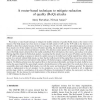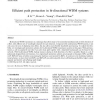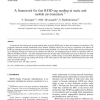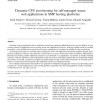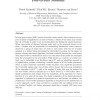CN
2008
13 years 11 months ago
2008
In high density (HD) IEEE 802.11 WLAN, packet loss can occur due to co-channel interference (asynchronous interference) or collisions (synchronous interference). In order to effec...
CN
2008
13 years 11 months ago
2008
We propose a router-based technique to mitigate the stealthy reduction of quality (RoQ) attacks at the routers in the Internet. The RoQ attacks have been shown to impair the QoS s...
CN
2008
13 years 11 months ago
2008
Bi-directional WDM transmission is a technique that allows data to be transmitted simultaneously in both directions of a fiber, with different sets of wavelength channels for each...
CN
2008
13 years 11 months ago
2008
This paper addresses the problem of fair allocation of bandwidth resources on lossy channels in hybrid heterogeneous networks. It discusses more particularly the ability of window...
CN
2008
13 years 11 months ago
2008
A framework for reducing the average reading time of passive RFID tags in dense environments is introduced. The proposed framework termed Accelerated Frame Slotted ALOHA (AFSA) ca...
CN
2008
13 years 11 months ago
2008
With the increasing deployment of wireless overlay networks, a mobile node with a range of network interfaces can be connected to multiple heterogeneous or homogeneous access netw...
CN
2008
13 years 11 months ago
2008
Overload control mechanisms such as admission control and connection differentiation have proven effective for preventing overload of application servers running secure web applic...
CN
2008
13 years 11 months ago
2008
Although there are two standard transport protocols, TCP and UDP, offering services in the Internet, the majority of the traffic over the Internet is TCP-based. TCP-based applicat...
CN
2008
13 years 11 months ago
2008
As more applications rely on underlying peer-to-peer topologies, the need for efficient and resilient infrastructure has become more pressing. A number of important classes of top...
CN
2008
13 years 11 months ago
2008
In large peer-to-peer (P2P) overlay networks, nodes usually share resources to support all kinds of applications. In such networks, a subset of the nodes may assume the role of br...

